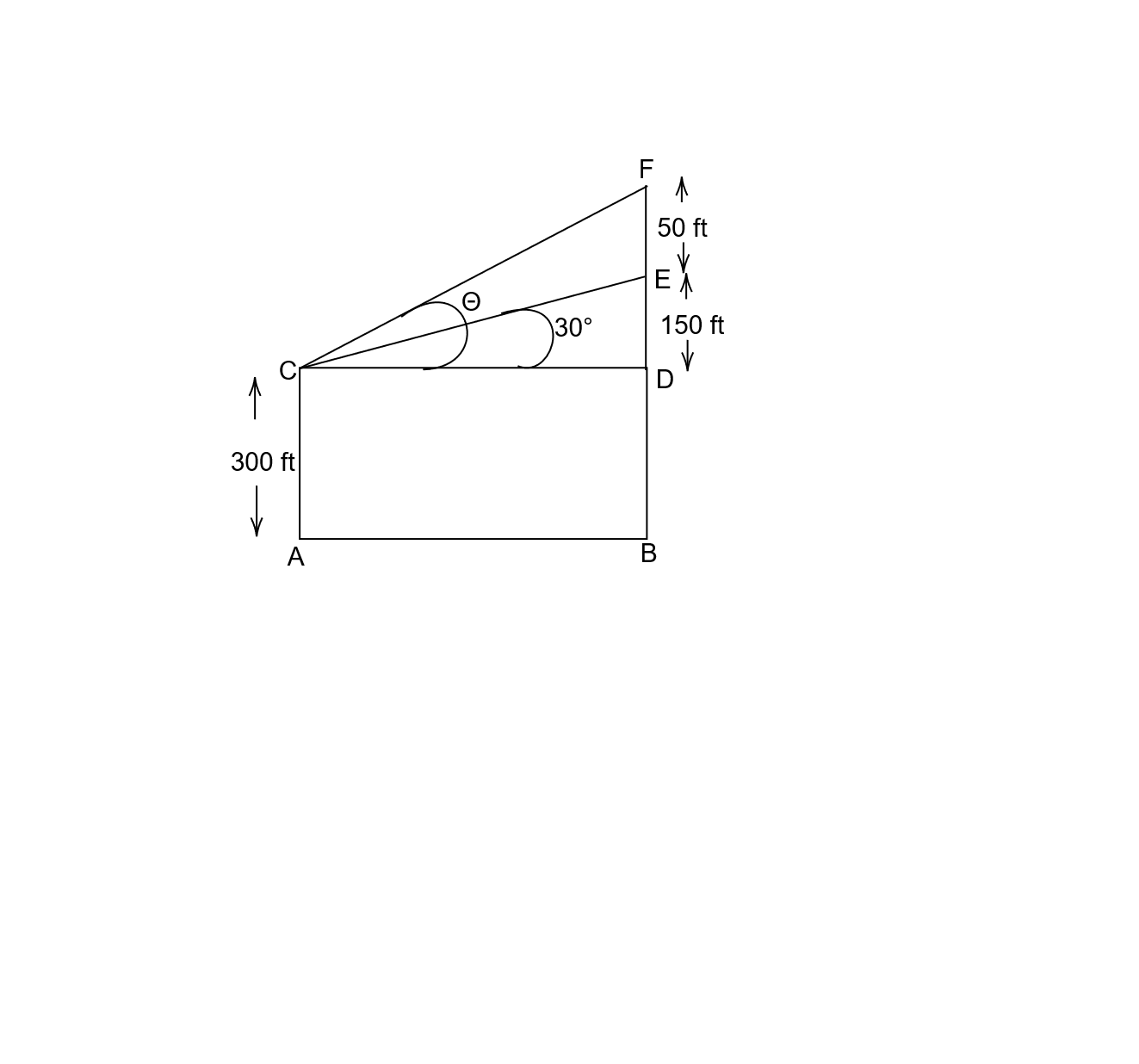
A flagpole stands on a building of height \[450{\text{ }}ft\] and an observer on level ground is \[300{\text{ }}ft\] from the base of the building . The angle of elevation of the bottom of the flagpole is \[30^\circ \] and the height of the flagpole is \[50{\text{ }}ft\] . If \[\theta \] is the angle of elevation of the top of the flagpole , then \[\tan \theta \] is
\[\left( 1 \right)\] \[\dfrac{4}{{3\sqrt 3 }}\]
\[\left( 2 \right)\] \[\dfrac{{\sqrt 3 }}{2}\]
\[\left( 3 \right)\] \[\dfrac{9}{2}\]
\[\left( 4 \right)\] \[\dfrac{{\sqrt 3 }}{5}\]
\[\left( 5 \right)\] \[\dfrac{{4\sqrt 3 + 1}}{6}\]
Answer
485.7k+ views
Hint: We have to find the value of \[\tan \theta \] in the given problem . We solve this question using the concept of applications of trigonometry . We should have the knowledge of the basic trigonometric functions and their values . We would construct a diagram for a reference and using the various relations of trigonometry and using the values of trigonometric functions we will find the value of \[\tan \theta \].
Complete answer: Given :
A flagpole stands on a building of height \[450{\text{ }}ft\] and an observer on level ground is \[300{\text{ }}ft\] from the base of the building . The angle of elevation of the bottom of the flagpole is \[30^\circ \] and the height of the flagpole is \[50{\text{ }}ft\] . \[\theta \] is the angle of elevation of the top of the flagpole .
Construct : According to the question , we construct a diagram as shown .

Now ,
In triangle \[DCE\] ,
\[\tan {30^ \circ } = \dfrac{{DE}}{{DC}}\]
[As we know that \[tan{\text{ }}x{\text{ }} = {\text{ }}\dfrac{{perpendicular}}{{base}}\]]
As , we know that \[\tan {30^ \circ } = \dfrac{1}{{\sqrt 3 }}\]
We get ,
\[\dfrac{1}{{\sqrt 3 }} = \dfrac{{DE}}{{DC}}\]
\[CD = \sqrt 3 \times DE\]
And , \[DE{\text{ }} = {\text{ }}150\]
So ,
\[CD = 150\sqrt 3 - - - (1)\]
In triangle \[DCF\] ,
\[\tan \theta = \dfrac{{FD}}{{CD}}\]
\[\left[ {FD{\text{ }} = {\text{ }}150{\text{ }} + {\text{ }}50{\text{ }} = {\text{ }}200} \right]\]
\[\tan \theta = \dfrac{{200}}{{150\sqrt 3 }}\]
Cancelling the terms , we get
\[\tan \theta = \dfrac{4}{{3\sqrt 3 }}\]
Thus , the value of \[\tan \theta \] is \[\dfrac{4}{{3\sqrt 3 }}\] .
Hence , the correct option is \[\left( 1 \right)\] .
Note:
Applications of trigonometry : It is the property or the concept of trigonometry which can be used in our daily life to either find the length or the angle of elevations of a body , building , the length of the formation of shadow of an object due to light . We can also compute the value or the measurement for the depth in the river of an object above it . This can also help us in finding the speed of an object moving in a direction which is seen by a person sitting on a height .
Complete answer: Given :
A flagpole stands on a building of height \[450{\text{ }}ft\] and an observer on level ground is \[300{\text{ }}ft\] from the base of the building . The angle of elevation of the bottom of the flagpole is \[30^\circ \] and the height of the flagpole is \[50{\text{ }}ft\] . \[\theta \] is the angle of elevation of the top of the flagpole .
Construct : According to the question , we construct a diagram as shown .

Now ,
In triangle \[DCE\] ,
\[\tan {30^ \circ } = \dfrac{{DE}}{{DC}}\]
[As we know that \[tan{\text{ }}x{\text{ }} = {\text{ }}\dfrac{{perpendicular}}{{base}}\]]
As , we know that \[\tan {30^ \circ } = \dfrac{1}{{\sqrt 3 }}\]
We get ,
\[\dfrac{1}{{\sqrt 3 }} = \dfrac{{DE}}{{DC}}\]
\[CD = \sqrt 3 \times DE\]
And , \[DE{\text{ }} = {\text{ }}150\]
So ,
\[CD = 150\sqrt 3 - - - (1)\]
In triangle \[DCF\] ,
\[\tan \theta = \dfrac{{FD}}{{CD}}\]
\[\left[ {FD{\text{ }} = {\text{ }}150{\text{ }} + {\text{ }}50{\text{ }} = {\text{ }}200} \right]\]
\[\tan \theta = \dfrac{{200}}{{150\sqrt 3 }}\]
Cancelling the terms , we get
\[\tan \theta = \dfrac{4}{{3\sqrt 3 }}\]
Thus , the value of \[\tan \theta \] is \[\dfrac{4}{{3\sqrt 3 }}\] .
Hence , the correct option is \[\left( 1 \right)\] .
Note:
Applications of trigonometry : It is the property or the concept of trigonometry which can be used in our daily life to either find the length or the angle of elevations of a body , building , the length of the formation of shadow of an object due to light . We can also compute the value or the measurement for the depth in the river of an object above it . This can also help us in finding the speed of an object moving in a direction which is seen by a person sitting on a height .
Recently Updated Pages
A man running at a speed 5 ms is viewed in the side class 12 physics CBSE

The number of solutions in x in 02pi for which sqrt class 12 maths CBSE

State and explain Hardy Weinbergs Principle class 12 biology CBSE

Write any two methods of preparation of phenol Give class 12 chemistry CBSE

Which of the following statements is wrong a Amnion class 12 biology CBSE

Differentiate between action potential and resting class 12 biology CBSE

Trending doubts
What are the major means of transport Explain each class 12 social science CBSE

Which are the Top 10 Largest Countries of the World?

Draw a labelled sketch of the human eye class 12 physics CBSE

Explain sex determination in humans with line diag class 12 biology CBSE

Explain sex determination in humans with the help of class 12 biology CBSE

Differentiate between homogeneous and heterogeneous class 12 chemistry CBSE




